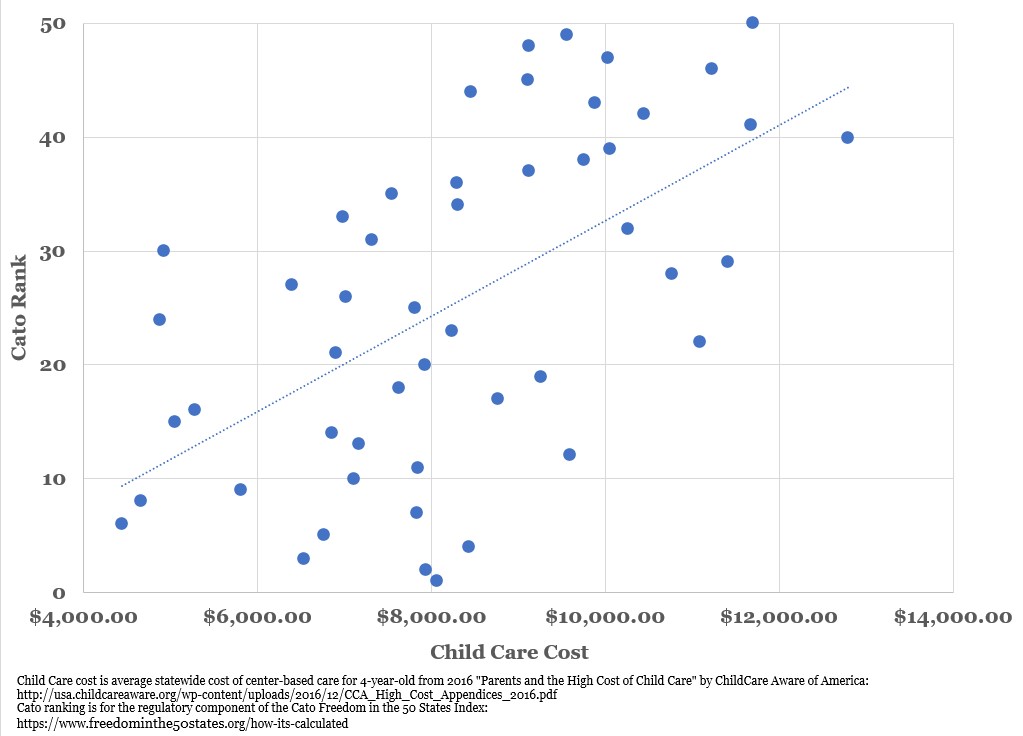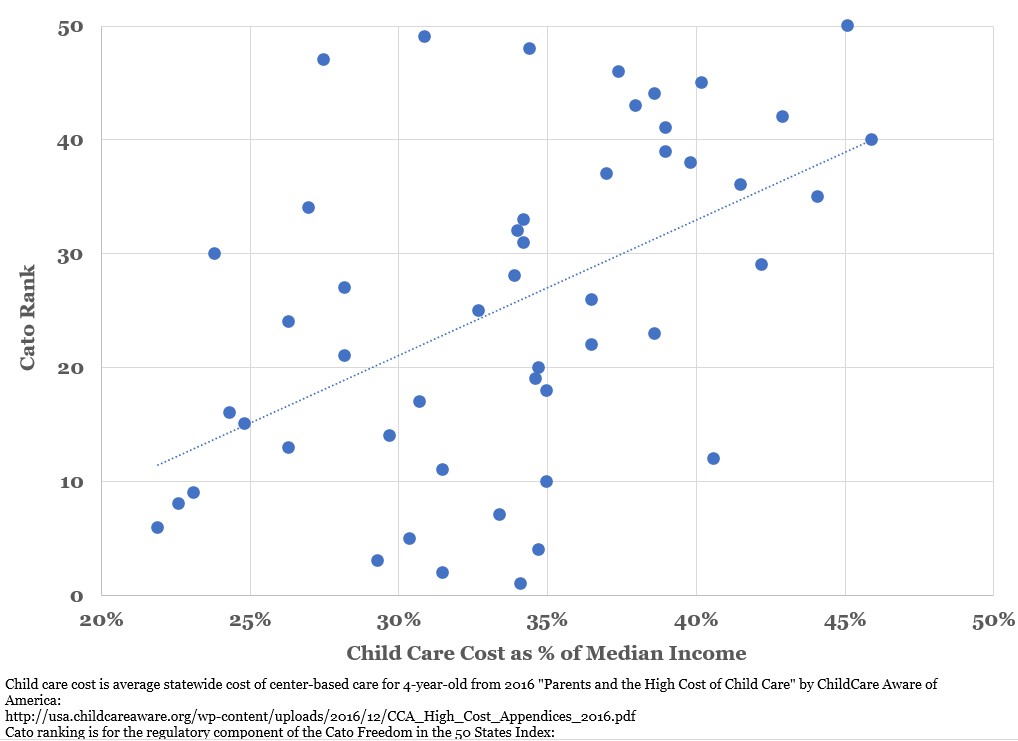The High Cost of Regulating Child Care
The push is on to address what has become a major problem for vast numbers of American families: the high cost of child care. This has become a major issue for policy, with presidential candidate and Senator Elizabeth Warren proposing a plan to subsidize the cost beyond 7 percent of a family’s income. Many voices echo the same concern.
In Massachusetts, for example, the average annual cost of child care is 65 percent of what the average single-parent family earns. This is not an untypical case, and motivates closer study of the industry. Is child care a luxury item that governments must subsidize, or is something preventing providers from offering services at prices the average family can and would pay?
This study provides new evidence that government regulation makes the problems faced by families and providers significantly worse. We take a close look at how child care is currently regulated and how this process could lead to artificially high prices. We then review the existing statistical evidence and contribute some new analyses showing the correlation between more regulation and higher child-care costs.
Like Senator Warren’s proposal, most analyses of the industry focus on the fact that its costs are high, rather than why they are so high. Even the most well-intentioned top-down regulation of child care will inevitably increase its costs and likely stifle innovation while having limited impact on the ultimate quality of the care provided.
The Cost of Child Care
The availability of affordable child care is a problem affecting lower- and middle-income families across the United States, but it differs substantially depending on where in the country they live. The table below shows minimum, average, and maximum costs in the 50 states. In each state, the advocacy group Child Care Aware tracks average costs for both center- and family-based care, for infants, toddlers, and four-year-olds.
Average Cost of Center-Based Child Care by State (2017)
The data reveal that while uniformly high, the average cost of child care varies substantially by state. Massachusetts, the highest-cost state, is between three and four times more expensive than Mississippi, the lowest-cost state, across all age groups. Indices estimate that the overall cost of living in Massachusetts is only about 1.5 times greater than Mississippi, suggesting factors specific to child care account for part of the wide gap.
But center-based infant care even in Mississippi is 25 percent of the average resident’s income. Family-based care (i.e., care in the home of a licensed and regulated provider) is also over 30 percent of income in most states for infants and over 25 percent for toddlers and four-year-olds.
One might think that the high price of child care simply covers the cost of producing quality care in a safe environment, and that the only “solution” is to help those who can’t afford it. But several recent articles attest to a perceived shortage of child care and to child-care “deserts” in some areas of the country. In the next section, we turn to government regulation as a potential reason why affordable child care is not being offered in the market.
Regulating Child Care
In the U.S., regulating child care is primarily the job of the states. While the federal government specifies some minimum standards and categories to be regulated, the ultimate standards can and do vary significantly by state. For example, the highest permissible child-to-staff ratio for toddlers and four-year-olds ranges from 5:1 in Maine, New York, and Vermont to 12:1 in Louisiana and Mississippi.
States can regulate child-care providers according to dozens or even hundreds of categories and requirements. In addition to ratio and overall group size, regulators can stipulate the education of staff, numerous health and safety codes, and requirements for continuing staff education, children’s immunizations, and square footage.
Mandating that states regulate a service like child care while giving each of the 50 state governments broad flexibility can lead to quirky results. For example, Idaho, unlike the other 49 states, does not impose a fixed ceiling on child-to-staff ratios but uses a point system based on various criteria to calculate the limit. In another example, the Denver Fire Department recently mandated that any facility caring for more than five children purchase a $30,000 sprinkler system.
Regulations such as these have clear impacts on providers’ capital and labor costs. Is something like the current system necessary to force the market to provide quality care, or might it actually inhibit quality care from being provided more affordably? To address this question, we must look in further detail at the relationship between regulation, child care, and quality of outcomes.
The purpose of regulating child care is to increase the probability of high-quality outcomes: children kept safe and healthy who enjoy and grow from their experience. But a centralized regulatory body, even in one of the smaller states, cannot possibly monitor these factors closely for every child, let alone separate child care from other factors contributing to these outcomes.
Regulators must therefore focus on mandating features of the care environment rather than outcomes. Diana Thomas and Devon Gorry (2015) summarize the literature on such features and child-care quality.
Researchers typically find that “process features” are the best observable predictors of quality outcomes. But process measures are based on observing the actual interactions between staff and children. If regulators made licensing or any government funding contingent upon these features, they would have to routinely monitor individual interactions at every center in a given state. For regulators, process measures are subject to the same measuring and monitoring problems as ultimate outcomes.
By necessity, regulators turn to “structural features” of the care environment. These are the measures discussed above, such as children-to-staff ratios, staff-education, space, and equipment requirements, and many more. Thomas and Gorry report several papers showing no direct statistical link between these measures and quality outcomes, though some indirect link through their influence on process features.
Contrast the situation of regulators with that of a parent or guardian. These primary caregivers are privy to information far less easy to measure or quantify. They are likely to know parents of older children who went through a program, or, even if new to a community, can relatively easily get a sense of a given provider’s reputation. When dropping off or picking up a child, they cannot help but observe direct interactions between staff and children.
By these and countless other informal mechanisms, parents are privy to a wealth of information about outcomes and process features that are unavailable to even the most competent and well-intentioned regulator. These tools will obviously be much more effective in the hands of parents who can and wish to be more involved, but they can filter through the community to all parents.
Finally, while regulators can never substitute for the on-the-ground knowledge of primary caregivers who live in a community with child-care providers, the opposite is far more feasible. That is, parents can monitor structural features at least as effectively as regulators. Crucially, they can also get an informal sense of how those measures interact with outcomes. If an innovative provider finds a way to offer great service while violating one or more of the frequently regulated structural measures, parents can observe and monitor far more efficiently than regulators.
Connecting the Dots
We have established that child care varies in price across states more than the average good or service. Industry regulations, which focus on aspects of the care environment that plausibly increase a business’s labor or capital costs, also vary widely by state. In this section, we establish a direct link between regulations and the price of care faced by families.
Several studies have sought to establish correlation and even causal links between child-care regulations and cost. Virtually all authors use regression analysis and the variation in regulations and cost across states to estimate the impact of specific regulations like those concerning children-to-staff ratio and staff education.
Randal Heeb and Rebecca Kilburn (2004) find that regulations have an economically significant effect on the price of child care, and in turn on demand for services and mothers’ participation in the labor force. David Blau (2007), in contrast, finds no significant link between specific regulations and prices, but does find a link between tougher regulations and lower staff wages, suggesting that centers pass some of the cost of regulations on to their employees.
Joseph Hotz and Mo Xiao (2011) look at supply-side impacts of child-care regulation and find that regulations reduce the number of firms providing services, especially in low-income areas, but do induce higher quality, especially in high-income areas. Thomas and Gorry (2015) find that easily observable and measurable regulations have a statistically significant impact on the price of child-care services.
The preponderance of the statistical evidence indicates a link between tougher government regulations and higher prices faced by families for child care. Below, we provide a brief and intuitive analysis whose results are complementary to those reported in the studies above.
While the studies above all use measurements of specific regulations, these can be difficult to measure and take into account. First, not all relevant regulations can be codified in a manner appropriate for regression analysis. Even a straightforward structural measure like children-to-staff ratio includes instances such as Idaho’s point system that must be imperfectly measured. Second, there are more regulations than can be simultaneously entered into a regression limited by the sample size of the 50 states.
If the studies above cast too narrow a net in capturing state-level regulations, We err on the opposite side by looking at the overall propensity of states to regulate all industries. The Cato Institute’s Freedom in the Fifty States project provides an index and rankings for each state to measure overall freedom. It also provides subindices for the components of the final index, including “Regulatory Freedom.” The regulatory-freedom index includes measurements of regulations across several industries, such as land-use, insurance, and labor-market regulations.
We combine Cato’s data on each state’s overall regulatory burden with data from the advocacy group Child Care Aware on the average cost of center-based care for a four-year-old in each state. We use the group’s 2016 report, which provides data for 2015 that line up with the data in Cato’s index.
We use two measures of cost faced by families: the absolute dollar price and price as a percentage of median single-parent family income in the given state. We intend the latter measure to account in part for the fact that higher-regulation states differ from lower-regulation states on demographic factors, such as income, likely to influence price.
The analysis thus uses overall regulatory propensity for each state as a proxy for the propensity to regulate child care. First, we regress each state’s average cost of care on its Cato regulatory-index value. As the table below shows, We find statistically and economically significant relationships between the two variables.
Regression Analysis: Average Cost of Child Care vs. States’ Regulatory Burdens
The regression coefficient of −8694.82 indicates that for a decrease of one full point (higher regulation) in the Cato index, a state’s child care will be $8,694.82 more expensive. The index ranges in value from −0.46 (New York) to 0.07 (Kansas), meaning that the model predicts economically significant swings of several thousand dollars from the highest- to the lowest-regulation states. The second model predicts a similarly economically significant swing of over 10 percent of median income.
The t-statistics indicate greater than 99 percent confidence that there is a correlation between higher regulation and higher cost, rather than the result being due to chance.
We can also capture the relationship between higher regulation and higher cost of child care visually. The scatter plots below substitute the more intuitive Cato regulatory ranking (1 being lowest regulation, 50 highest) for the value of the index.
Average Cost of Child Care vs. Cato Regulatory Ranking
Average Cost of Child Care as % of Median Income vs. Cato Regulatory Ranking
The graphs and regressions suggest the same conclusion: states with higher overall measured regulations tend to have higher costs for child care.
Conclusion
Child care in the United States bears the tell-tale signs of an industry with barriers to entry. A limited number of incumbents charge prices that put the service out of reach to all but higher-income families. Meanwhile, people complain of shortages, especially in lower-income areas. This articles results, as well as those in other recent studies, provide a robust confirmation of common sense: regulations that add to a business’s labor and capital cost will form barriers to entry, leading to high prices and low availability.
Hotz and Xiao (2011) find that while higher prices cause wealthier families to switch into still-regulated family-based care, lower-income families are more likely to fall off the map. They either use unofficial channels, like leaving children with relatives, or are forced to work less themselves. While lower regulations could lead to some bad individual outcomes, one must also note that children slip through the cracks under the status quo.
One way to address the issue is Senator Warren’s $70 billion per year proposal, though beyond its cost centralized plans still suffer from the same monitoring issues as those currently faced by regulators. Less burdensome and more simplified regulations must be an option on the table as plans like these are discussed.
Reducing regulations intended to protect the wellbeing and safety of children is not a comfortable topic, nor should it be. But given the number of children and families struggling under the status quo, it is very possible that lower regulations could reduce costs while on balance improving well-being and safety. The high cost of child care is far from inevitable.

















